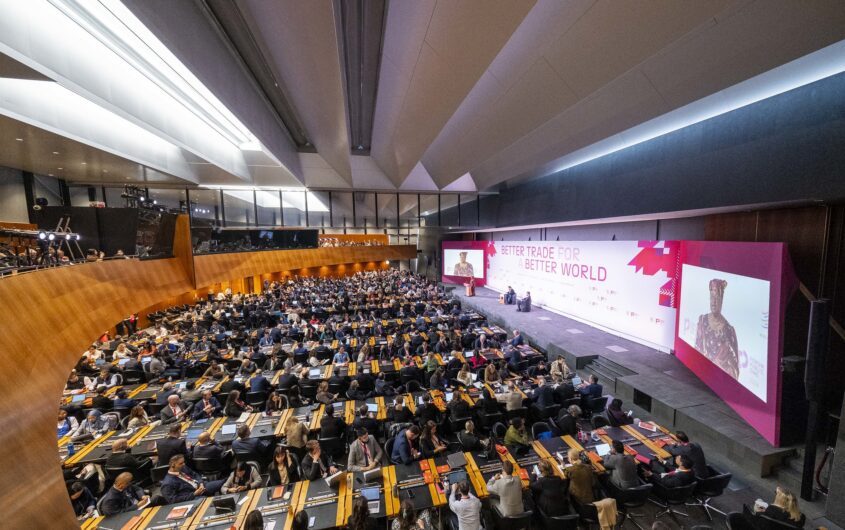
WTO/Tomas Cesalek BAP Services via Flickr
Peering into the Global Trading System of 2035

Peter S. Rashish
Vice President; Director, Geoeconomics Program
Peter S. Rashish, who counts over 30 years of experience counseling corporations, think tanks, foundations, and international organizations on transatlantic trade and economic strategy, is Vice President and Director of the Geoeconomics Program at AICGS. He also writes The Wider Atlantic blog.
Mr. Rashish has served as Vice President for Europe and Eurasia at the U.S. Chamber of Commerce, where he spearheaded the Chamber’s advocacy ahead of the launch of the Transatlantic Trade and Investment Partnership. Previously, Mr. Rashish was a Senior Advisor for Europe at McLarty Associates, Executive Vice President of the European Institute, and a staff member and consultant at the International Energy Agency, the World Bank, UN Trade and Development, the Atlantic Council, the Bertelsmann Foundation, and the German Marshall Fund.
Mr. Rashish has testified before the House Financial Services Subcommittee on International Monetary Policy and Trade and the House Foreign Affairs Subcommittee on Europe and Eurasia and has advised three U.S. presidential campaigns. He has been a featured speaker at the Munich Security Conference, the Aspen Ideas Festival, and the European Forum Alpbach and is a member of the Board of Directors of the Jean Monnet Institute in Paris and a Senior Advisor to the European Policy Centre in Brussels. His commentaries have been published in The New York Times, the Financial Times, The Wall Street Journal, Foreign Policy, and The National Interest, and he has appeared on PBS, CNBC, CNN, NPR, and the BBC.
He earned a BA from Harvard College and an MPhil in international relations from Oxford University. He speaks French, German, Italian, and Spanish.
The year is 2035. During much of the last twenty-five years, the international economic system has faced tumult. Geopolitical fractures and domestic political upheavals played their part as they steered trade policy in a more nationalist and coercive direction. But so did related shortcomings in fora like the World Trade Organization, the G20, or even the short-lived U.S.-EU Trade and Technology Council for developing rules for the global economy that did a better job of promoting transatlantic objectives.
It is already clear, however, that these past twenty-five years can usefully be divided into a “before” and “after” period—the first when the post-war, multilateral settlement was struggling to adapt and progress slowed to a crawl; and the second, when what is already being referred to as the “geoeconomic system” began to emerge.
The main elements contributing to the global economic disorder of this period’s earlier years are well known:
- China Shock 1.0 hitting traditional manufacturing regions in the United States, leading to dissatisfaction with both free trade policies and the political elites who oversaw them;
- The failed launch of an early strategic approach to trade policy as the Trans-Pacific Partnership and the Transatlantic Trade and Investment Partnership during the Obama administration and later the Global Agreement on Sustainable Steel and Aluminum under President Biden never made it over the finish line;
- China Shock 2.0 challenging even advanced industries—especially automobiles, and machinery—in Germany and countries in its supply chain ecosystem;
- An unruly artificial intelligence landscape where private sector actors are dominant, and, during the mid-2020s, neither national governments nor international agreements are able to assert cross-border rules and norms, and
- The flouting (to a greater or lesser extent) of World Trade Organization rules by China’s industrial subsidies, President Trump’s second-term tariffs, countries agreeing trade deals with Washington to gain stability and predictably, and then in 2027, when, in the face of increasing climate events, the European Union decides to pursue its Carbon Border Adjustment Mechanism despite an adverse ruling by the WTO’s dispute settlement body.
By the end of the decade, however, it becomes clear that neither the traditional free-trade model nor the later, more nationalist approach is capable of righting trade imbalances, creating jobs, or containing inflation on a sustainable basis. A bipartisan consensus in the United States takes shape around the idea that while unfairness had developed in the global trading system—and both reform of existing institutions and the creation of new ones are essential—part of the solution needs to start at home.
By 2035, a diverse group of countries accounting for a majority of the world’s economic output agree it is worth the extra time and effort needed to participate in this new “geoeconomic system” compared to the unpredictable and conflict-prone world of the 2020s.
Domestic policies that several countries in the EU continue to rely on to manage the ups and downs of globalization are looked at as a possible model: a stronger social safety net for the short term combined with more robust apprenticeship, training, and adjustment policies provided either by the state or by private companies.
In 2035, this new global economic order remains a work in progress, but many of its contours are becoming apparent. While the WTO, UN specialized agencies like the International Telecommunications Union or the World Intellectual Property Organization, and the G20 continue to exist, they are flanked by a Venn diagram of new groupings tailored to particular issues and strategic interests. Such coalitions of the willing have already formed for climate policy, economic security, AI, and industrial subsidies. They do not all have the same membership and greater resources of economic statecraft are required to manage this more complex policy setting.
But a diverse group of countries accounting for a majority of the world’s economic output now agree that it is worth the extra time and effort needed to participate in this geoeconomics-driven form of globalization compared to the unpredictable and conflict-prone world of the 2020s.








